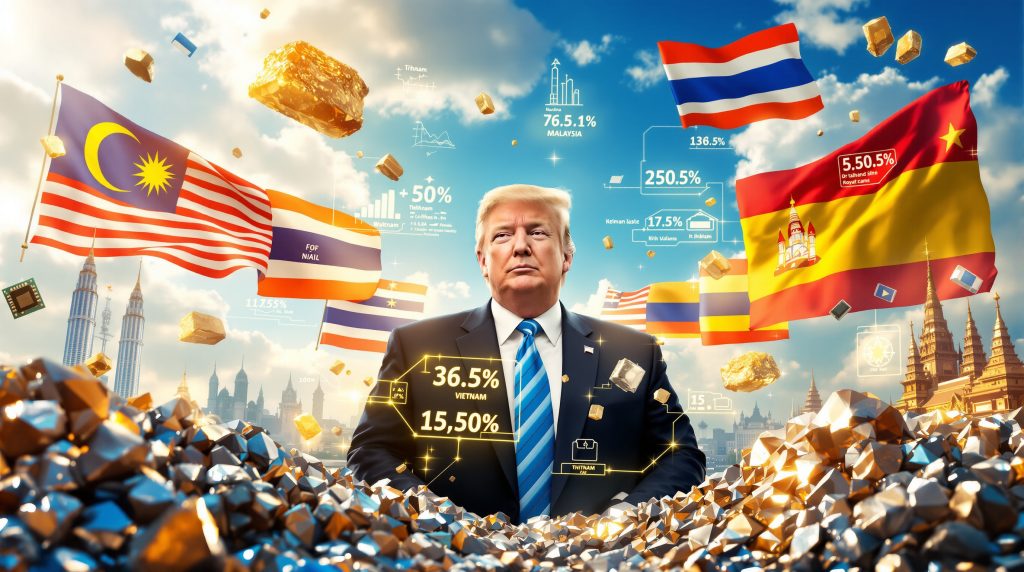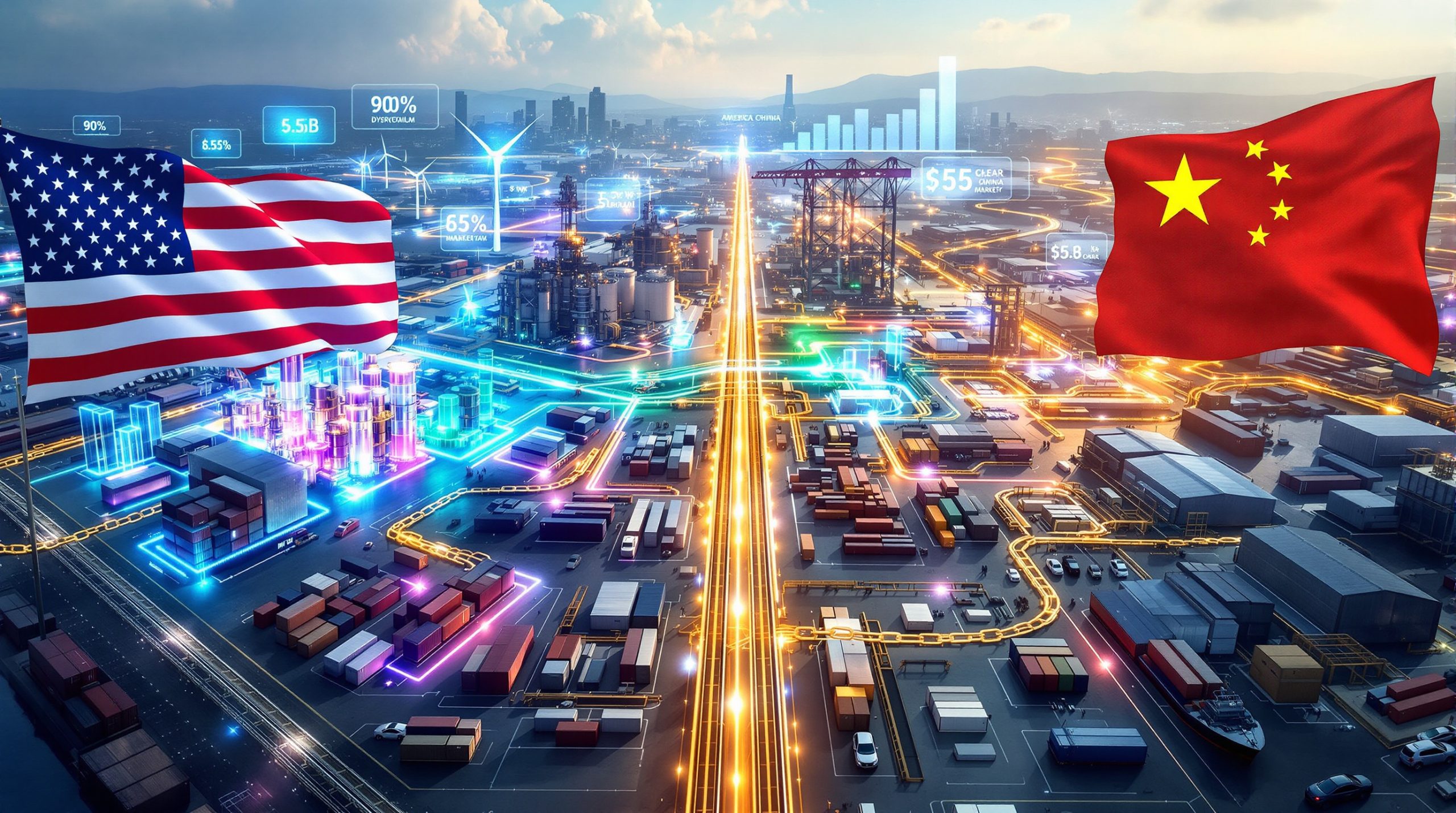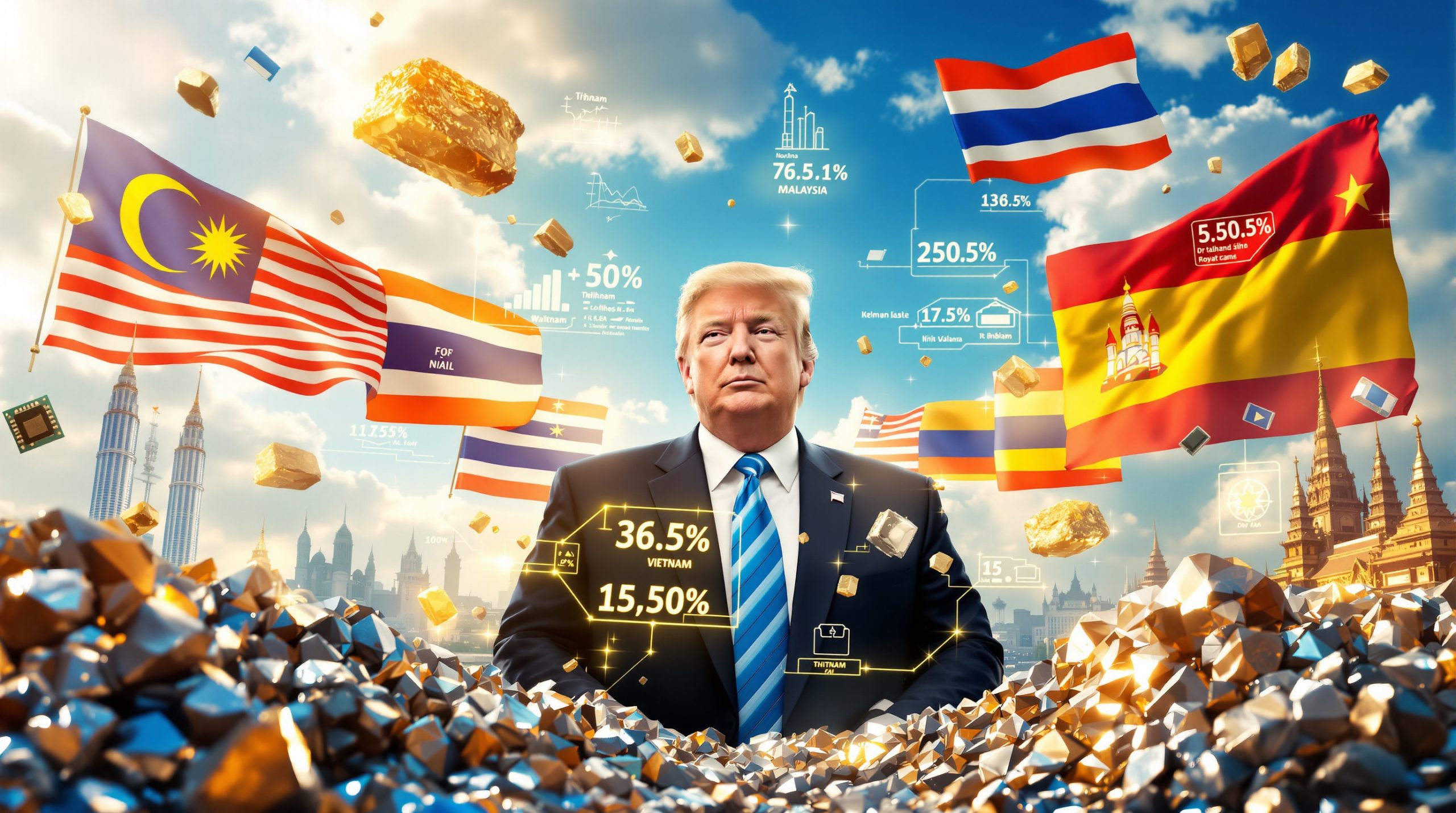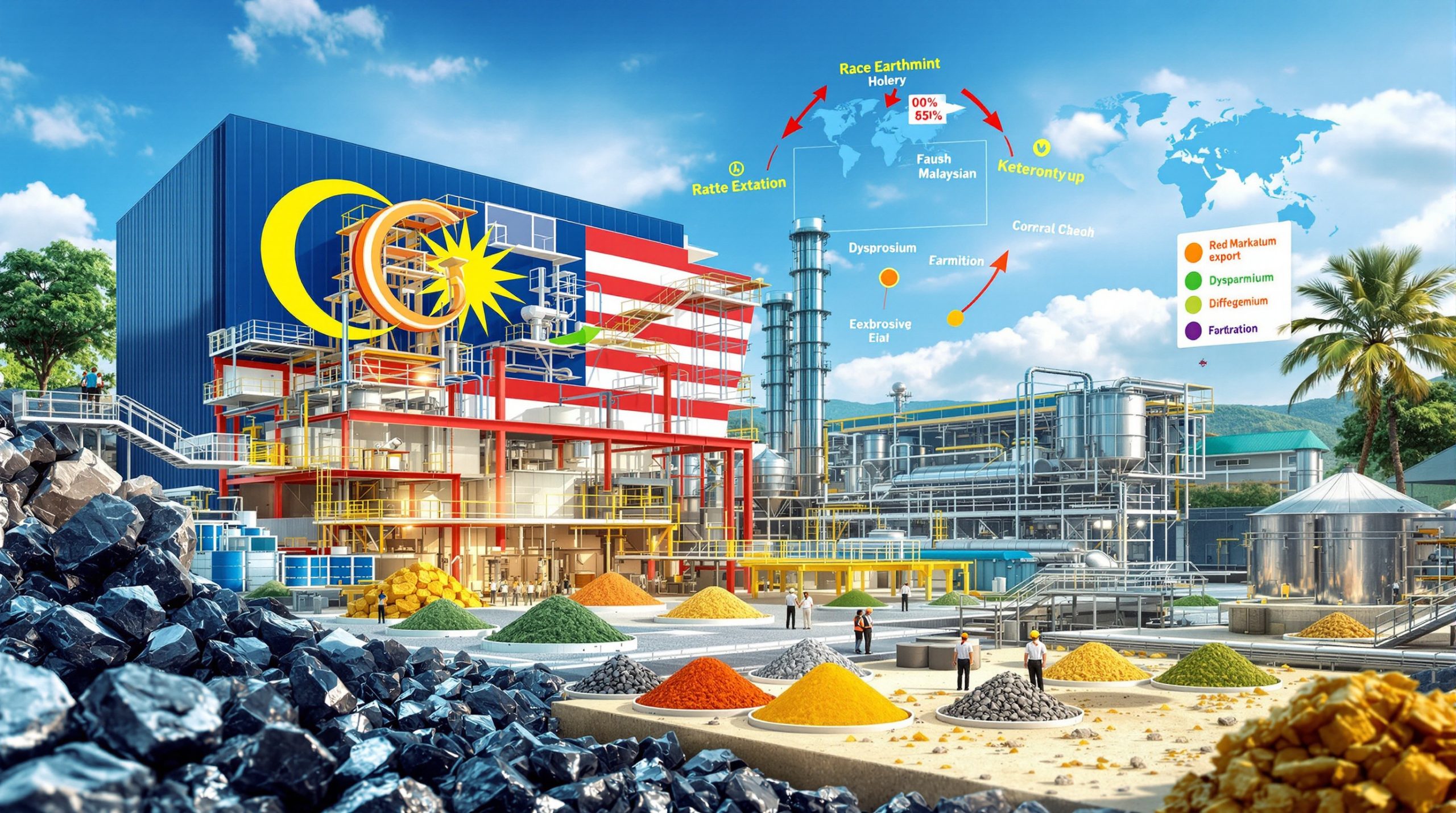Understanding the Strategic Shift in Critical Minerals Partnerships
Recent trade agreements between the United States and Southeast Asian nations have fundamentally altered the global critical minerals landscape. These comprehensive partnerships represent a calculated response to China's tightening grip on rare earth processing and export controls, creating new pathways for mineral supply chain diversification. Trump strikes deals on trade and critical minerals in Southeast Asia has become a defining moment for global supply chain security.
The strategic importance of these agreements extends beyond traditional trade relationships, encompassing national security considerations and technological independence. As global manufacturers face increasing uncertainty over critical mineral supplies, Southeast Asia emerges as a viable alternative to Chinese dominance in processing capabilities.
What Critical Minerals Agreements Were Secured During Recent ASEAN Negotiations?
Malaysia's Rare Earth Export Commitments
Malaysia's commitment to maintain unrestricted critical minerals exports to the United States represents a significant shift in regional trade dynamics. The country's substantial 16.1 million tonnes of rare earth deposits position it as a crucial player in global supply chain diversification efforts.
The Malaysian government's agreement to refrain from imposing export bans or quotas on critical minerals demonstrates a clear departure from China's restrictive export policies. However, Malaysia maintains its prohibition on raw rare earth exports, emphasising downstream processing development within its borders.
This strategic approach creates opportunities for joint ventures between Malaysian and American companies in refining technologies. The focus on value-added processing rather than raw material exports aligns with Malaysia's industrial development goals while addressing US supply security concerns.
Malaysia's position as a global leader in halal certification adds another dimension to trade relations, with streamlined requirements for US pharmaceuticals and cosmetics creating additional market opportunities beyond minerals.
Thailand's Critical Minerals Framework Agreement
Thailand's bilateral cooperation framework establishes comprehensive mechanisms for supply chain diversification across multiple sectors. The agreement encompasses mineral processing capabilities, telecommunications infrastructure investments, and significant commercial commitments totalling $18.8 billion in aircraft purchases.
The framework includes substantial agricultural commitments, with Thailand pledging $2.6 billion in annual purchases of US feed corn and soybean meal. These agricultural components complement mineral agreements by creating balanced trade relationships that benefit both nations' economic interests.
Energy sector commitments totalling $5.4 billion annually in liquefied natural gas and crude oil purchases further strengthen bilateral ties. This comprehensive approach demonstrates how critical minerals agreements integrate with broader strategic partnerships.
Thailand's agreement to eliminate tariff barriers on approximately 99% of goods creates unprecedented market access opportunities. Furthermore, the relaxation of foreign ownership restrictions in telecommunications sectors opens new avenues for US investment in critical infrastructure.
How Do These Deals Address China's Rare Earth Export Controls?
Breaking China's Processing Monopoly
China's dominance in rare earth refining technology has created vulnerabilities across multiple industries dependent on these materials. However, recent export controls have intensified global manufacturers' urgency to secure alternative supply sources, making Southeast Asian partnerships increasingly valuable.
The processing capabilities being developed in Malaysia and Thailand offer alternatives to Chinese refining monopolies. These facilities can handle various stages of mineral processing, from initial separation to final purification for industrial applications.
Key advantages of Southeast Asian processing include:
- Reduced transportation costs compared to African or South American alternatives
- Established industrial infrastructure supporting mineral processing operations
- Favourable regulatory environments for foreign investment partnerships
- Geographic proximity to major Asian manufacturing centres
China's increasingly stringent export controls have created market opportunities for alternative suppliers. Consequently, the timing of these Southeast Asian agreements capitalises on global uncertainty about Chinese supply reliability.
Strategic Mineral Security for US Industries
Critical minerals secured through these agreements serve essential functions across multiple high-technology sectors. Semiconductor manufacturing requires specific rare earth elements for chip production, while electric vehicle batteries depend on lithium, nickel, and cobalt supplies.
Industry Dependencies by Sector:
| Industry | Critical Minerals | Primary Applications |
|---|---|---|
| Semiconductors | Rare earth elements, gallium | Chip fabrication, electronic components |
| Electric Vehicles | Lithium, nickel, cobalt | Battery production, electric motors |
| Defence Equipment | Rare earth magnets, titanium | Guidance systems, aircraft components |
| Renewable Energy | Neodymium, dysprosium | Wind turbine generators, solar panels |
Military equipment and defence industry requirements add national security dimensions to these supply chains. Advanced weapons systems, radar equipment, and communications technology all depend on stable access to critical minerals.
The diversification strategy reduces single-point-of-failure risks while creating competitive alternatives to Chinese suppliers. This approach strengthens negotiating positions for US manufacturers in global commodity markets, while energy transition security remains paramount.
What Are the Economic Terms of These Trade Agreements?
Tariff Structure and Trade Balance Improvements
The tariff framework establishes 19% rates for Malaysia, Cambodia, and Thailand, with 20% for Vietnam, while incorporating selective zero-tariff provisions for specific goods categories. These structured approaches balance trade protection with market access objectives.
Vietnam's commitment to address its $123 billion trade surplus with the United States represents a significant economic rebalancing effort. The agreements include specific targets for reducing trade imbalances through increased US product purchases.
Market access provisions create opportunities for US agricultural and industrial products across Southeast Asian markets. These reciprocal arrangements ensure mutual benefits rather than one-sided trade relationships.
The tariff structures incorporate flexibility mechanisms allowing adjustments based on trade performance and compliance with agreement terms. This adaptive approach enables responses to changing market conditions.
Commercial Purchase Commitments and Investment Frameworks
Thailand's agricultural purchase commitments of $2.6 billion annually create substantial market opportunities for US corn and soybean producers. These agreements provide predictable demand for American agricultural exports.
Energy sector commitments totalling $5.4 billion in LNG and crude oil purchases establish long-term supply relationships benefiting US energy producers. These arrangements create stable revenue streams while supporting energy security objectives.
Infrastructure and aerospace investments demonstrate the comprehensive nature of these partnerships. The $18.8 billion aircraft purchase commitment supports US manufacturing while modernising Thai transportation capabilities.
Implementation timelines span multiple years, creating sustained economic impacts rather than short-term transactions. This approach builds lasting partnerships supporting long-term strategic objectives.
Why Is Southeast Asia Critical for US Supply Chain Diversification?
Geographic Distribution of Critical Resources
Southeast Asia's mineral wealth encompasses diverse deposits essential for modern technology applications. The region's geological formations contain significant quantities of lithium, nickel, and rare earth elements crucial for industrial applications.
Regional Mineral Resources:
- Malaysia: 16.1 million tonnes rare earth deposits, tin mining capabilities
- Thailand: Industrial mineral processing facilities, tungsten resources
- Vietnam: Nickel deposits, bauxite reserves for aluminium production
- Cambodia: Emerging exploration programmes, untapped mineral potential
Proximity to major Asian manufacturing hubs provides logistical advantages over alternative supply sources. Transportation costs and delivery times significantly favour Southeast Asian suppliers over African or South American alternatives.
Regional processing capabilities continue expanding through foreign investment and technology transfer programmes. These developments create integrated supply chains reducing dependence on Chinese processing facilities, while Australia's minerals strategic reserve provides additional security considerations.
Geopolitical Risk Mitigation Strategies
Diversifying supply sources reduces vulnerability to single-country export restrictions or political disruptions. The Southeast Asian approach creates multiple alternative pathways for critical mineral supplies.
Building resilient supply chains requires balancing cost efficiency with supply security considerations. Southeast Asian partnerships offer competitive pricing while providing greater supply reliability than single-source arrangements.
Alternative pathways for technology sector inputs ensure continued production capabilities during supply disruptions. These redundant systems protect against both natural disasters and political interference.
Long-term strategic implications extend beyond immediate supply needs to encompass broader US-China competition dynamics. Successful Southeast Asian partnerships demonstrate viable alternatives to Chinese economic influence, particularly in response to Trump's minerals mandate.
How Do These Agreements Impact Global Mining Investment?
Investment Opportunities in Southeast Asian Mining
Malaysian sovereign wealth fund partnerships create opportunities for refinery development and technology transfer. These arrangements combine Malaysian capital with international expertise in mineral processing.
Thai mining sector liberalisation enables increased foreign ownership in critical projects. Regulatory changes facilitate international investment while maintaining local economic benefits.
Vietnamese mineral processing expansion potential attracts significant international investment. The country's industrial development programmes prioritise value-added manufacturing over raw material exports.
Risk assessments for international mining companies must consider regulatory stability, infrastructure quality, and local partnership requirements. Southeast Asian markets generally offer favourable investment climates with established legal frameworks.
Market Response and Future Projections
Stock market reactions to Southeast Asian mining investments reflect investor confidence in regional diversification strategies. Companies with established regional operations have shown improved market valuations.
Commodity price implications vary by specific mineral types and processing stages. Increased Southeast Asian production capacity may moderate price volatility while ensuring supply security.
Production capacity expansion timelines span multiple years, requiring sustained investment commitments. The gradual increase in regional output will progressively reduce dependence on Chinese suppliers.
Integration with existing global supply chains requires coordination between multiple stakeholders. Successful implementation depends on alignment between governmental agreements and commercial partnerships, whilst mining industry innovation continues driving efficiency improvements.
What Are the Environmental and Labour Standards Requirements?
Environmental Protection Commitments
Sustainability standards embedded in trade agreements establish baseline requirements for mining operations. Environmental monitoring frameworks ensure compliance with international best practices.
Key environmental protections include:
- Water quality monitoring and protection measures
- Air emission controls for processing facilities
- Waste management and tailings disposal standards
- Biodiversity conservation requirements in mining areas
Comparison with international mining best practices demonstrates Southeast Asian commitment to responsible resource development. These standards align with global sustainability initiatives while supporting economic development.
Impact assessments for local communities and ecosystems require ongoing monitoring and remediation programmes. Transparent reporting mechanisms ensure accountability for environmental performance.
Labour Rights and Social Responsibility
Worker protection standards in mining operations must meet international labour organisation requirements. Safety protocols, fair wages, and working condition standards apply to all covered facilities.
Community engagement requirements ensure local populations benefit from mining developments. Revenue sharing, employment opportunities, and infrastructure development support regional economic growth.
Skills development and technology transfer provisions create long-term capacity building opportunities. Training programmes develop local expertise while supporting industrial development objectives.
Alignment with international labour standards ensures worker rights protection while maintaining competitive operational costs. These balanced approaches support sustainable industry development.
How Do These Deals Compare to Previous US Trade Strategies?
Evolution from Earlier Trade Policies
The collaborative approach represents a significant shift from previous confrontational trade strategies. Partnership-based frameworks replace tariff wars and trade disputes with mutual benefit arrangements.
Learning from earlier trade disruptions has informed more sophisticated negotiation strategies. Current agreements balance American interests with partner country development objectives.
Strategic recalibration for regional influence recognises Southeast Asia's growing importance in global supply chains. These partnerships acknowledge regional countries as strategic partners rather than subordinate suppliers.
The comprehensive nature of current agreements addresses multiple economic sectors simultaneously. This integrated approach creates stronger partnerships than single-issue trade arrangements, particularly considering US‑China trade impacts.
Long-term Strategic Vision for Indo-Pacific Relations
Economic prosperity frameworks emphasise mutual development rather than zero-sum competition. These approaches build lasting partnerships supporting regional stability and growth.
Integration with broader US foreign policy objectives aligns trade agreements with security partnerships and diplomatic initiatives. Coordinated strategies maximise American influence while respecting partner sovereignty.
Coordination with allies enhances the effectiveness of Southeast Asian partnerships. Japanese, Australian, and European cooperation strengthens alternative supply chain development.
Sustainable development goals ensure environmental and social responsibility while pursuing economic objectives. This balanced approach builds public support for long-term partnerships.
What Challenges Could Affect Implementation Success?
Technical and Logistical Hurdles
Infrastructure development requirements include transportation, power generation, and processing facility construction. These capital-intensive projects require multi-year implementation timelines.
Technology transfer and knowledge sharing face barriers including intellectual property protection and skills gaps. Overcoming these challenges requires sustained cooperation between technical teams.
Regulatory harmonisation between countries involves complex legal and administrative processes. Standardising requirements across multiple jurisdictions requires ongoing coordination efforts.
Timeline coordination for complex multi-national projects demands careful project management and stakeholder alignment. Success depends on maintaining momentum across multiple implementation phases.
Political and Economic Risk Factors
Domestic political changes in partner countries could affect agreement implementation. Electoral outcomes, policy shifts, and leadership changes create ongoing uncertainty factors.
Global commodity market volatility influences project economics and investment decisions. Price fluctuations affect the commercial viability of specific development projects.
Competition from Chinese investment initiatives continues challenging US partnerships. Beijing's alternative financing and development programmes offer competing options for regional governments.
Regional security considerations affect investor confidence and operational stability. Territorial disputes, regional tensions, and security threats create risk factors for long-term projects.
Critical Minerals Trade: Strategic Questions and Answers
Which minerals are considered most critical in these agreements?
The agreements prioritise rare earth elements including neodymium, dysprosium, and praseodymium essential for high-technology applications. Lithium, nickel, and cobalt for battery production represent another critical category addressed through these partnerships.
Gallium and germanium, crucial for semiconductor manufacturing, receive special attention due to Chinese export restrictions. Industrial minerals like tungsten and fluorite also feature in supply diversification strategies.
How will these deals affect global lithium and rare earth prices?
Increased Southeast Asian production capacity may moderate price volatility by reducing market concentration. However, significant price impacts require several years of capacity development and production ramp-up.
Competition between Chinese and Southeast Asian suppliers could stabilise pricing while improving supply security. Long-term price trends depend on demand growth rates versus production capacity expansion.
What timeline exists for implementing these trade frameworks?
Initial implementation phases focus on regulatory harmonisation and infrastructure planning, requiring 12-18 months. Major processing facility construction spans 3-5 years depending on project complexity.
Full supply chain integration may require 5-7 years to achieve meaningful Chinese supply alternative capability. Interim measures include strategic stockpiling and incremental capacity additions.
How do these agreements benefit Southeast Asian economies?
Foreign investment in mining and processing creates employment opportunities while building industrial capabilities. Technology transfer programmes develop local expertise supporting long-term economic development.
Value-added processing generates higher revenues than raw material exports. Infrastructure development for mining projects benefits broader economic development objectives.
Revenue sharing arrangements ensure local communities benefit from resource development. Export earnings strengthen national balance of payments while supporting currency stability.
These strategic partnerships have also attracted attention from international observers, with industry analysts noting the comprehensive nature of the agreements. Moreover, regional experts have highlighted how these deals could fundamentally reshape global supply chains.
Disclaimer: This analysis is based on trade agreement frameworks and industry trends. Specific implementation outcomes depend on multiple economic, political, and technical factors that may change over time. Investment decisions should consider comprehensive risk assessments and professional advice. Commodity price predictions involve significant uncertainty and should not be considered investment recommendations.
Ready to Capitalise on the Next Critical Minerals Discovery?
Discovery Alert's proprietary Discovery IQ model delivers real-time alerts on significant ASX mineral discoveries, instantly empowering subscribers to identify actionable opportunities ahead of the broader market as global supply chains diversify. Understand why major mineral discoveries can lead to substantial market returns by exploring Discovery Alert's dedicated discoveries page, showcasing historic examples of exceptional outcomes, and begin your 30-day free trial today to position yourself ahead of the market.




